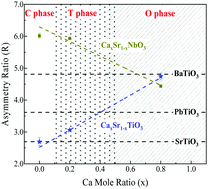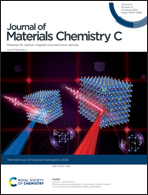Photoluminescence detection of symmetry transformations in low-dimensional ferroelectric ABO3 perovskites†
Abstract
Symmetry-dependent properties such as ferroelectricity are suppressed at room temperature in Pb-free ABO3 perovskites due to antiferrodistortive dynamics (octahedral rotations/tilts), resulting in the preferential stabilization of centrosymmetric crystals. For this reason, defect engineering (Ca doping, oxygen vacancy, etc.) has been leveraged to break the symmetry of these crystals by inducing symmetry/structural transitions to modify the local A/B-site environment. This work demonstrates the use of in situ/ex situ photoluminescence spectroscopy to systematically detect symmetry/structural transformations in prototypical ferroelectric ABO3 perovskites. These baseline optical responses are compared to recently synthesized CaxSr1−xNbO3 (CSNO) nanocrystals, which undergoes similar ferroelectric/structural phase transitions. Furthermore, the resultant PL response is corroborated with X-ray diffraction (XRD) and absorption spectroscopy (XAS) measurements to confirm the structural changes. This ability to directly monitor the local site symmetry within ABO3 perovskites via photoluminescence spectroscopy can be used to screen for temperature- and defect-induced ferroelectric transitions.

- This article is part of the themed collections: Journal of Materials Chemistry C Emerging Investigators and Journal of Materials Chemistry C HOT Papers


 Please wait while we load your content...
Please wait while we load your content...
